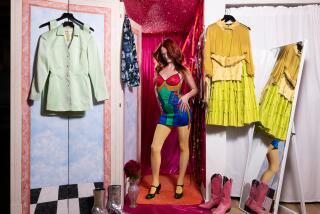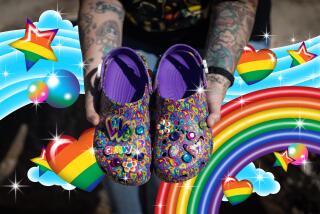2 Mail-Order Firms Want to Grow--Right Along With the Kids : Apparel: Right Start and Patagonia hope to avoid the mail-order catalogs wars by pushing harder into the children’s clothing field.
- Share via
Two local companies best known for their success with catalogues, Right Start Inc. and Patagonia Inc., have found a way to keep growing in an increasingly cutthroat mail-order business: children’s clothes.
Ventura-based Patagonia actually started a separate children’s clothing catalogue eight years ago. The idea originated with the company’s owners, Yvon and Malinda Chouinard, who then had small children of their own. The Chouinards figured there would be a market for smaller versions of the expensive, high-quality outdoor wear sold in Patagonia’s well-established adult catalogue. Today those items include kids’ snowsuits for $175 each, lightweight jackets made from recycled plastic ($50), riding tights ($98) and sweats ($19 to $30).
Right Start branched into children’s apparel just last year. Based in Westlake Village, Right Start was founded eight years ago by President Stanley M. Fridstein and Chief Executive Lenny M. Targon. It grew to $42.3 million in revenue in its last fiscal year, largely on the strength of its mail-order catalogue, which offers an unusual blend of baby products ranging from quilts and diaper bags to child safety products and educational toys aimed at youngsters up to age 4.
But growth in that business is now tapering off and profit margins are narrowing, in part because of the extra costs of finding new customers. Figuring it was cheaper to buy into an existing children’s clothing business than start one from scratch, Right Start last year acquired Children’s Wear Digest in Richmond, Va., which specializes in upscale, brand-name clothes for kids up to age 12. Right Start used some of the cash raised from its 1991 initial public stock offering to close the deal.
Despite the time lag, Patagonia and Right Start now generate about the same amount of revenue from children’s apparel sales.
Patagonia’s kids’ clothing revenue--including sales at its 13 company-owned retail stores and to other retail outlets--has grown more than twice as fast as sales of its adult apparel in the last four years. Children’s clothing now accounts for 12%, or about $13.5 million, of Patagonia’s $112 million in annual sales.
Pam Murphy, director of children’s products for Patagonia, attributes the success of the children’s clothing line in part to the company’s zeroing in on a specific market that had little direct competition. “I fit into the niche of functional outdoor clothing,” she said. “I will never have cute little pink and blue baby sleepers.”
As for Right Start, since the acquisition of Children’s Wear Digest, kids’ clothing sales have zoomed from about $3 million annually to an expected $12 million for 1993, an increase Fridstein said was made possible by the financial resources and mailing list expertise Right Start provided. What’s more, results from the kids’ catalogue helped Right Start’s profits jump 26% in its fiscal year ended May 26, to $1.03 million.
Fridstein said that Children’s Wear Digest’s appeal lies in its mix of upscale, brand-name children’s clothing, such as dresses, suits and casual outfits, mostly in the $30 to $60 range, from companies such as Esprit, Good Lad, Laura Dare and Guess Kid’s. This is a market, he said, that has been ignored by most other mail-order houses and abandoned by many department stores.
Although the Right Start baby catalogue remains the company’s anchor, Fridstein and Targon said Children’s Wear Digest helps them hang onto the company’s mostly upscale customers as their kids pass age 4.
“What we’re aiming to do is grow the business vertically so we can keep our customer base for a longer period of time,” Fridstein said.
Fridstein and Targon’s strategy was to buy an existing catalogue with a proven customer base and add to that with selected customers from its own list. It’s a strategy that makes sense, said Paul Miller, senior news editor at Catalog Age, a mail-order industry magazine. “It wouldn’t surprise me to see Right Start go after a catalogue that’s for kids a little older, the next level up,” he said.
Despite the good receptions for their children’s apparel so far, Right Start and Patagonia still face risks.
Mary Roberts, chief operating officer of Hanna Andersson in Portland, Ore., which is considered to be the biggest children’s clothing mail-order company with $45 million in sales, said there were few others in the business when Hanna Andersson mailed its first catalogue in 1984. Today, there are 25 catalogues specializing in children’s apparel, according to Catalog Merchandiser, an industry newsletter.
“When we look back at the last 10 years, it has become enormously more competitive,” Roberts said.
Among the newer entrants in the field are giant mail-order firm Lands’ End, which started a separate kids catalogue three years ago, and L. L. Bean, another veteran mail-order company, which this year created a separate children’s division.
As a result, the shakeout occurring in the overcrowded mail-order industry has spread to children’s clothing catalogues. One victim is New Hampton Inc., the New York publisher of the Brights Creek catalogue specializing in lower-priced children’s clothing, which filed for bankruptcy protection and was sold to Spiegel Inc. in August. Spiegel is reportedly trying to sell Brights Creek.
Right Start also has stumbled in kids’ apparel. Last week it said it would stop publishing its Weebok catalogue of clothes and shoes for babies, and take a $480,000 write-off of inventory and other costs. The company had mailed two versions of the Weebok catalogue this year to a small portion of its mailing list to see if the idea would work. Half the cost was paid by Reebok International Ltd., the athletic shoe and apparel company, which markets kids’ products under the Weebok brand name.
William Gibson, an analyst at Cruttenden & Co., an Irvine-based investment banking firm, said the Weebok catalogue may have failed because the prices were too high at a time when many people are tightening their belts. The Weebok catalogue, for instance, offered denim pants for $27.95.
And despite the good results from Children’s Wear Digest so far, Right Start had a disappointing fiscal first quarter ended Aug. 25, with its profit sinking 37% from a year earlier to $184,000, despite a 65% surge in revenue to $15.9 million. Targon attributed the lower earnings in part to an economic climate that continues to dampen consumer spending, dragging down Right Start’s revenue per catalogue mailed.
By contrast, Patagonia’s sales of children’s clothing have been only marginally affected by the weak economy. Murphy said that’s probably because Patagonia keeps its mailings very selective, focusing on proven customers who have the disposable income to buy the pricey clothes. It also helps, she said, that Patagonia offers certain hard-to-find features that upscale consumers appreciate, including reinforced seams and reflective safety marking in jackets. It even has a kid’s fishing vest that is a miniature version of a product from Patagonia’s adult catalogue.
Patagonia tests many of its kids’ clothes on employees’ children. And the company’s in-house day-care facility in Ventura comes in handy when designers need models or size checks.
Both Right Start and Patagonia are also looking to other business opportunities as a way to keep growing. The two companies are set to make a big push in retail, another common--though not always successful--means of expansion for mail-order companies.
Some cataloguers, such as Williams Sonoma and Eddie Bauer, have found a winning formula with a blend of mail order and retail. Although retail stores typically take away some mail-order sales, a catalogue can serve as a good advertising vehicle and helps build name recognition when a retailer enters a new market.
Both Right Start and Patagonia are hoping to make retail a big part of their business. Patagonia now owns and operates 13 Great Pacific Iron Works stores, carrying merchandise from the catalogue and other outdoor equipment. Each shop has a separate kids section.
Also, about two years ago, Patagonia began selling part of its children’s line through wholesale dealers to sporting goods retailers such as Sport Chalet, a move that resulted in a spurt in its children’s clothing sales. Murphy also plans to start selling the kids apparel to children’s specialty stores, which she believes will broaden the audience for Patagonia’s products.
One day Murphy hopes to open Patagonia-owned shops carrying only children’s apparel.
Right Start opened its first retail outlet two years ago at its headquarters building in Westlake Village. It now also has two stores in Atlanta, plus a Laguna Beach store, and this month opened another shop in Pleasanton. If the Pleasanton store proves successful, Fridstein and Targon plan to roll out as many as 10 new stores in 1994 and up to 20 the following year.
The Right Start stores carry only merchandise from the company’s namesake catalogue. There is no plan for the stores to carry apparel because, Fridstein said, he doesn’t want to stray from the formula that made the Right Start catalogue popular.
Analyst Gibson thinks Right Start’s retail expansion is a good move because it offers a higher potential return on investment than catalogues. “The real future of Right Start is going to be as a retailer,” he said.
Another reason for mail-order companies to expand into retail is that the cost of mailing catalogues has been rising. Whenever postal rates go up, Right Start and Patagonia take a direct hit to their bottom lines.
That has the two companies thinking about still more ways to get their products before potential customers.
Patagonia’s Murphy thinks new video- and computer-based shopping services could one day be a major avenue for sales. Patagonia’s products can now be ordered through the Prodigy and CompuServe computer services, but Murphy said it is too soon to gauge the response.
More to Read
Inside the business of entertainment
The Wide Shot brings you news, analysis and insights on everything from streaming wars to production — and what it all means for the future.
You may occasionally receive promotional content from the Los Angeles Times.











